“We are now the clear number one music streaming service in India, judging by engagement. As engagement grows, our playbook momentum continues to increase.” – Alex Norström, the chief freemium business officer at Spotify, sounded happy, and perhaps a little relieved when he spoke these words at the Spotify Investor Day presentation in early June 2022.
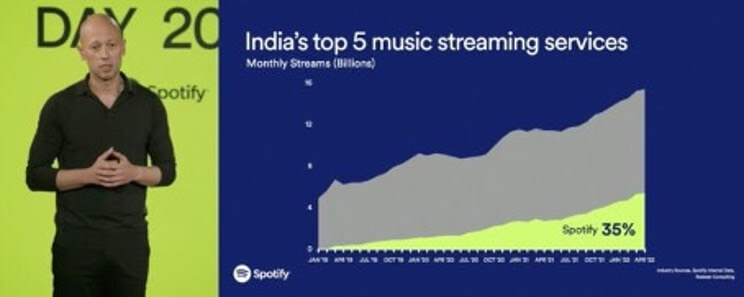
Alex Norström during Spotify Investor Day 2022
Spotify has reason to be excited. Just as for Netflix and Amazon Prime, India is the Everest to be conquered for Spotify. The Indian music streaming market is projected to cross $900M by 2025. This is just a small slice of the potential pie, since user penetration by 2025 is expected to be only 6%, leaving a large headroom for growth.
Category Challenges in the Indian music market
Let’s take a look at a typical Indian music consumer. She loves listening to music. Unlike video which demands undivided attention, music can complement pretty much any job in her life, in addition to forming its own source of entertainment.
However, she faces a couple of issues when it comes to enjoyable music consumption:
Discoverability – No one wants to listen to songs they don’t like. But there are literally billions of songs, and finding the few that she wants to listen to is a complex task. Left to herself, finding the right song for the occasion would be very taxing cognitively. It also comes with the nagging sensation that she is leaving out finding new songs which she would have liked had she gotten a chance to listen to them.
Popularity – Music is a leading indicator of the popular culture, and knowing about and enjoying the ‘right’ music will increase her popularity with her peers. Music is also a great social adhesive. But in order to use it effectively, it’s important not just to know the currently popular songs, but also to know them when it matters. Keeping up with the hit songs of the season is a chore usually best left to someone more ‘in the know’.
Relevance – This is a slightly more nuanced problem. In addition to popular music, she also likes to listen to music that’s personal and relevant to her. This could range from hidden gems to regional language hits to classics. She needs a steady diet of these as well to round up her musical meal. And in a country like India with dozens of regional languages and rich musical heritage, it’s not easy to consistently unearth or acquire relevant songs to keep her engaged. This is much more of a problem in India than in other more homogenous language markets.
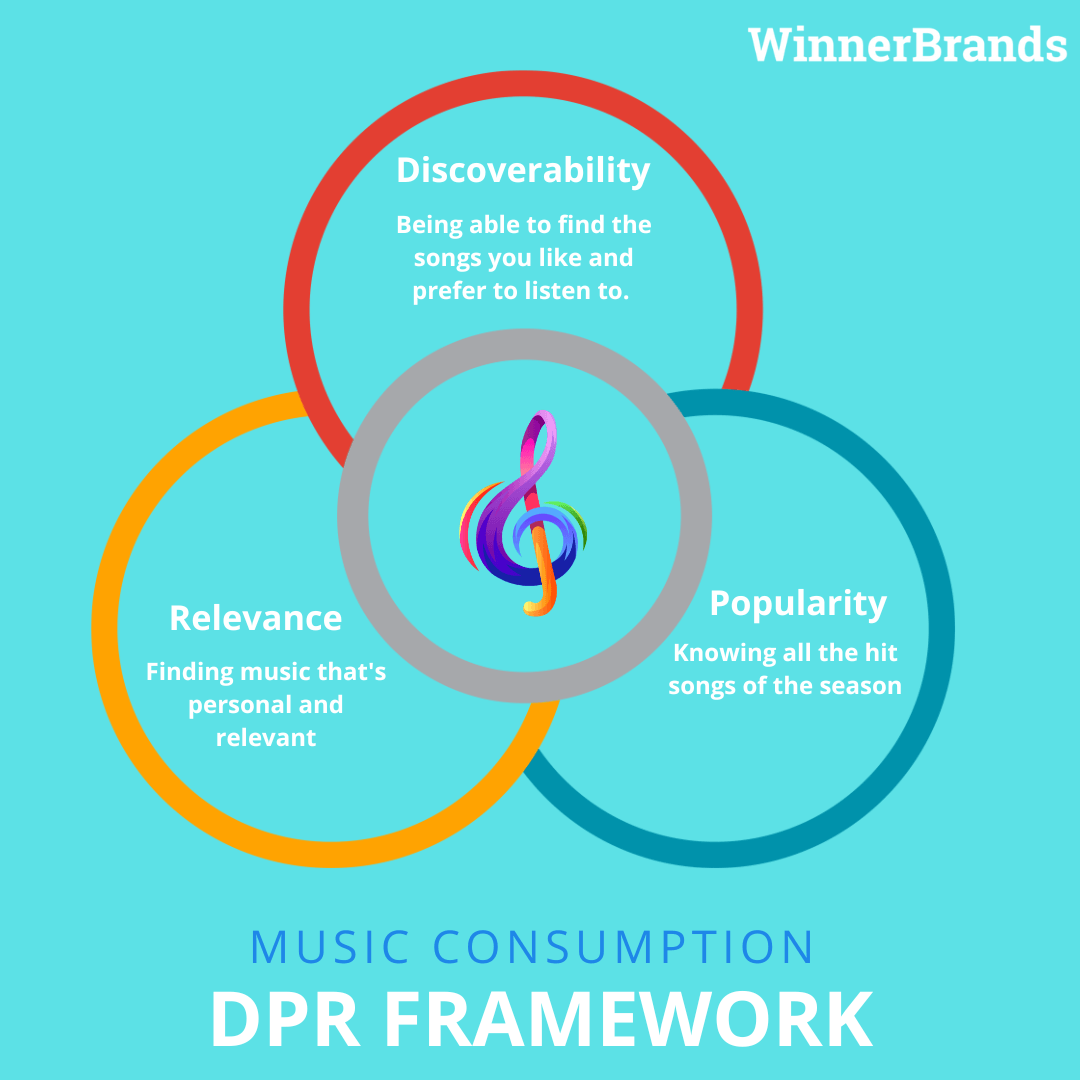
Any music streaming player looking to acquire and retain this customer would need to cater to these needs.
Further, unlike video streaming, where players like Netflix and Amazon Prime pour in billions to acquire original content, there is precious little differentiation in the audio industry. Most popular songs that are available to JioSaavn will be available to Gaana and Spotify as well.
So if everyone is equal, how do you differentiate? And if consumers can easily move from platform to platform to listen to music, how do you keep them coming back to you?
And how do you do it when you are one of the last players to enter the party?
You do it by using an age-old marketing mantra – Positioning. It’s all about occupying a clear mind space in the minds of your potential consumers. And Spotify’s positioning is around playlists. Right from its early days, Spotify has stood for playlists in the minds of consumers.
Curating a world “for me”
Consumers today increasingly feel like leading a ‘curated’ life where news, views, content and even ads are customized as per their unique needs, preferences or world-view. This has led to more focus on cherry-picking parts of the world they feel best suit their desires and wants, and creating “experiences” that define those needs. This is where playlists become important.
Because they solve all three challenges – Discoverability, Popularity and Relevance, by letting consumers not only build a list of songs that are relevant to them but also by letting them discover popular and relevant songs from their friends.
Curated playlists have become so pervasive that both brands and personalities have latched on to this trend.
It’s no surprise then that when Barack Obama launched the first part of his presidential memoir “A Promised Land,” he preceded it with the release of a playlist of songs.
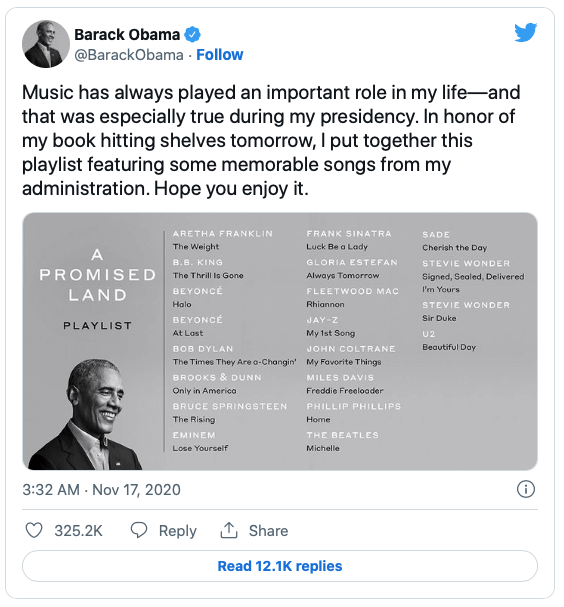
And he released his playlist on Spotify. That was no coincidence.
Brands are not far behind either. Fitness enthusiasts regularly turn to motivational music to keep themselves inspired during workouts. Nike cleverly used playlists to curate their own music their customers could work out to.
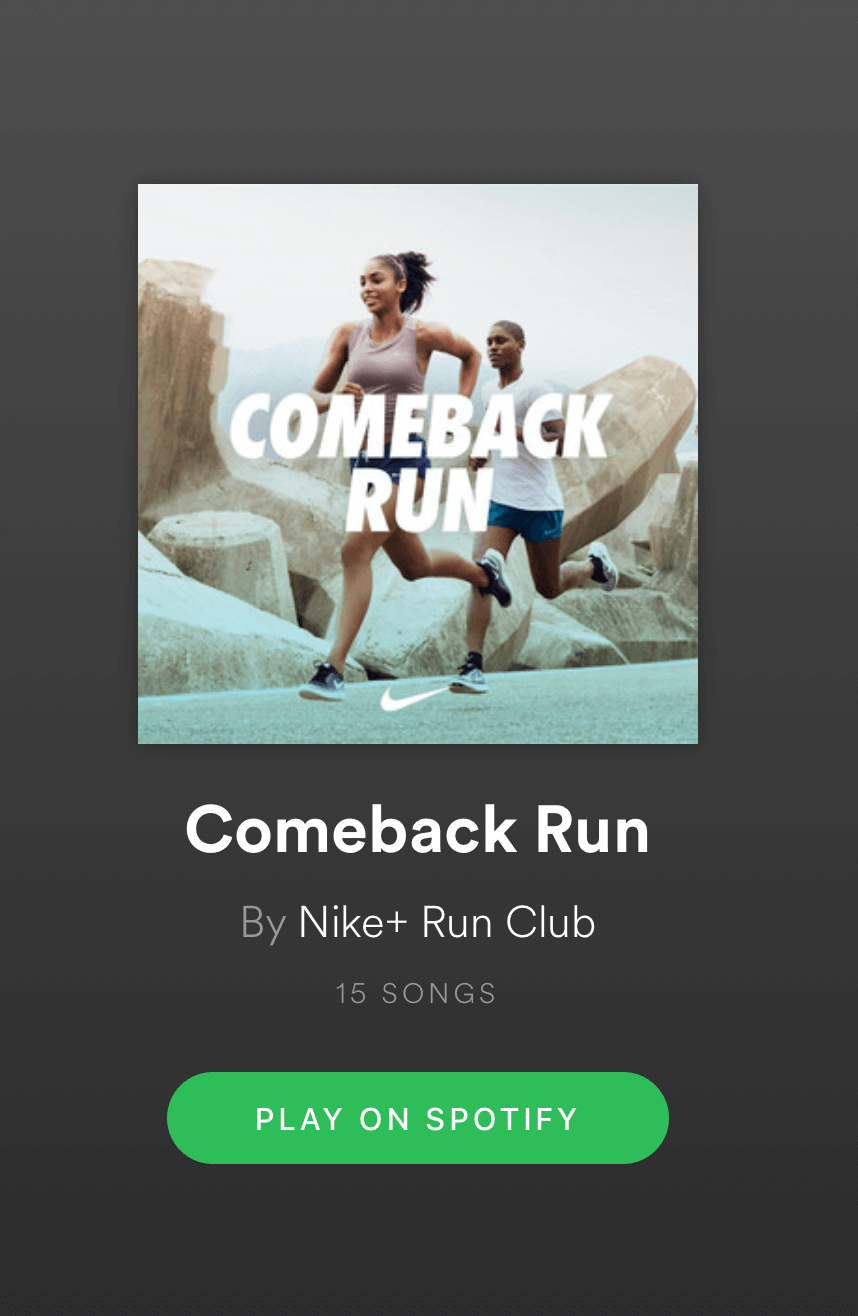
Well begun is half done – identifying a solid positioning helped clarify a strong communication strategy for Spotify. The next step was to bring it to life through the line for the consumers to raise awareness.
And Spotify has succeeded in that endeavour so far. Their communications game in India has been mostly spot-on, and has succeeded in landing its positioning in the consumer’s mind.
These are the reasons why they were able to do that:
1. Clear and single-minded communication from launch
Spotify’s key direct competitors in the Indian market, Gaana and JioSaavn, started their communications in 2014. They spent 5 years building the streaming category in India before Spotify made its entrance in 2019. During this early phase, both JioSaavn and Gaana focused on building the nascent streaming category and driving a behaviour change in Indian consumers, encouraging them to stream songs instead of downloading them. They focused on key messages like the power of music to set and create moods and emotions, as well as the benefits of streaming vs downloading.
Then Spotify came in and cleverly built on top of that.
Almost from the outset, Spotify focused on clear and sharp communication of its positioning, with its now famous “There’s a playlist for that” campaign.
This clear, single-minded communication helped instantly differentiate Spotify from its competition. This step almost seemed prescient when the overall category growth exploded in the very next year (2020) because of the pandemic-induced shutdown. When more and more people began accessing music streaming to fill idle time at home, Spotify, with its clear differentiation, was in a great spot to acquire these new category entrants. Within 2 years of launch, Spotify cornered 15% of the market share, at par with Wynk Music.
2. Hyperlocal contextual messaging for instant recognition
Perhaps the most well-known execution of “There’s a playlist for that” campaign are the famous billboards. The billboards featured aptly named playlist names and the text used to describe situations reflected the social fabric of urban India brilliantly, thus immediately resonating with the target consumer.
Hyperlocal contextual messaging also ensured that the messages themselves reflected the cultural zeitgeist of the location in which they were placed.
For instance, this board appeared in Bengaluru, India’s startup hub:
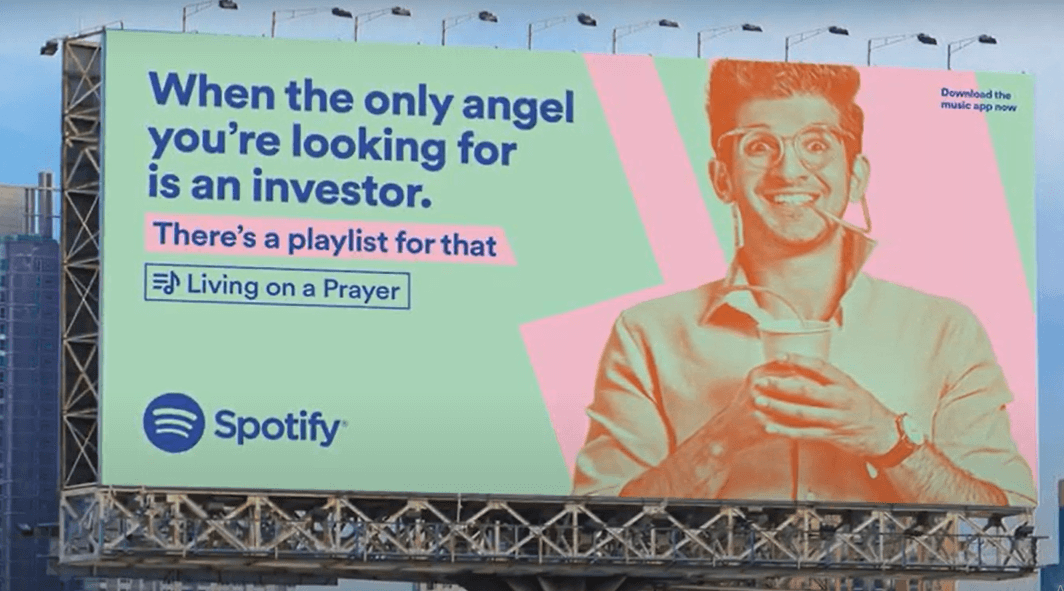
Whereas this board appeared in Mumbai:
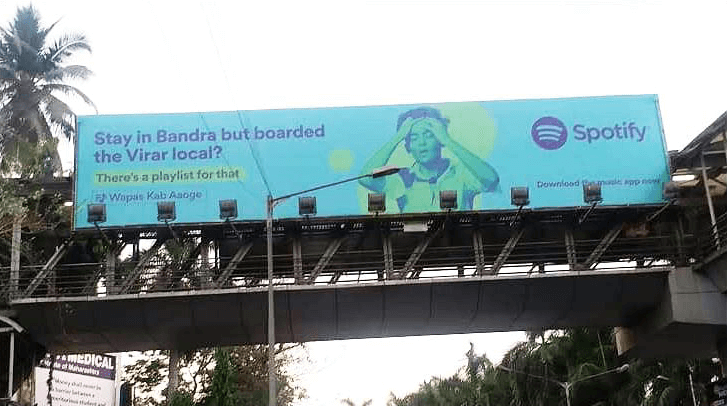
Speaking about the success of the campaign, Neha Ahuja, India Marketing head for Spotify had this to say:
3. Getting the social media game right
Spotify has played a great social media game from the beginning.
A great example of this is their IPL 2019 campaign, where even though Spotify wasn’t an official sponsor, it cleverly rode on the IPL wave by covering the match ball by ball and providing a relevant playlist for each commentary, with its #HarBallPePlaylist campaign.
By the end of a match, they had tweeted out 250 playlists over a period of 4 hours, garnering a reach of 4.45M, generating a lot of engagement.
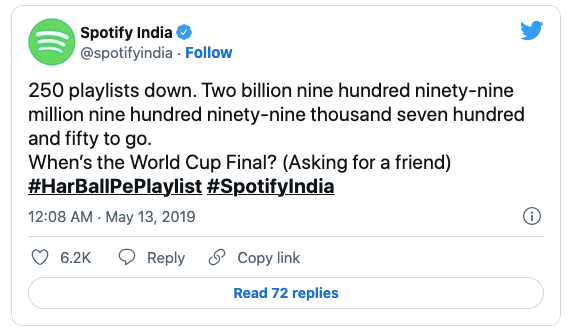
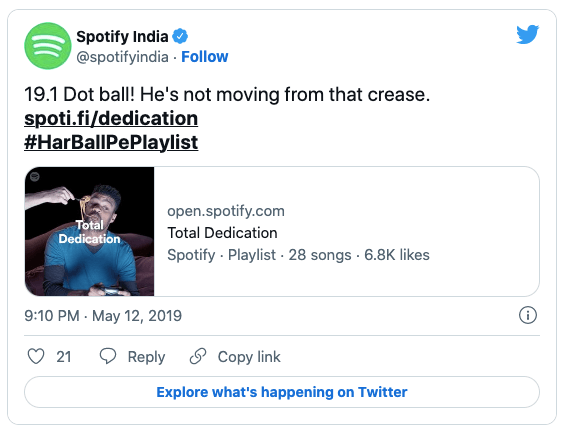
Influencers also joined in the fun:
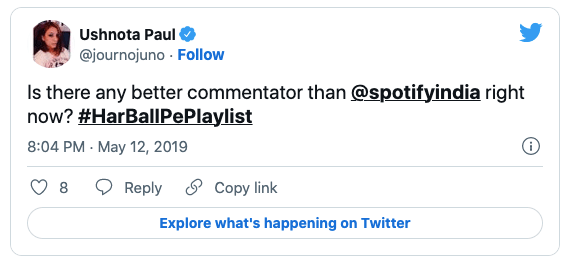
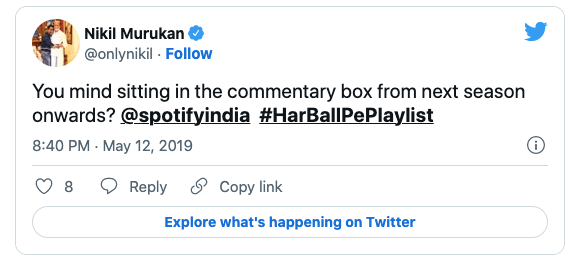
Again, on World Music Day, Spotify drove high engagement with its #PlayThis campaign. In response to users tweeting an emoji representing their mood, Spotify shared a relevant playlist with them.
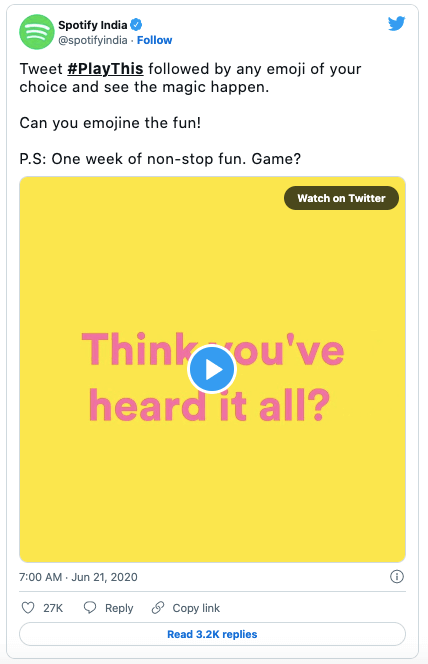
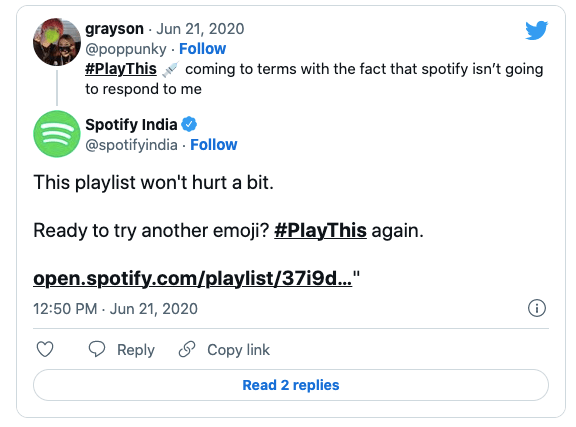
This is in addition to regular celebrity and influencer tie-ups for promoting customised playlists.
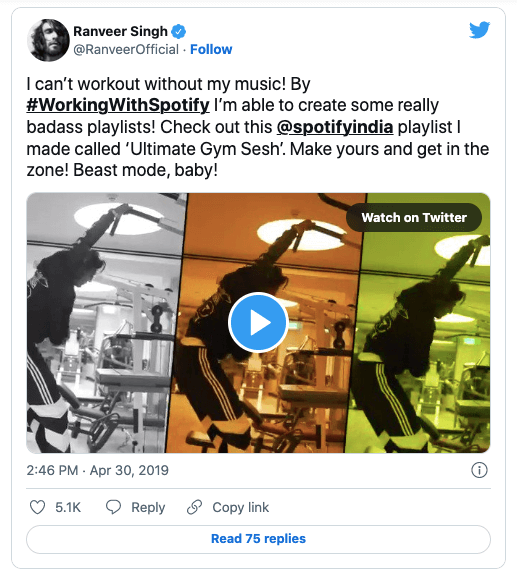
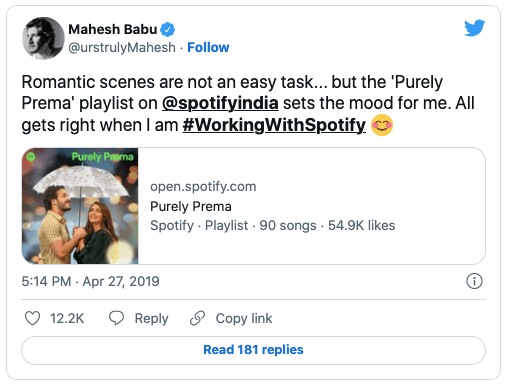
Spotify continued its focus on playlists with its now famous Wrapped campaigns, showcasing a playlist of the most played songs in India annually. This campaign is yet another example of how Spotify is able to leverage its technological ability to create an emotional connection with its consumers.
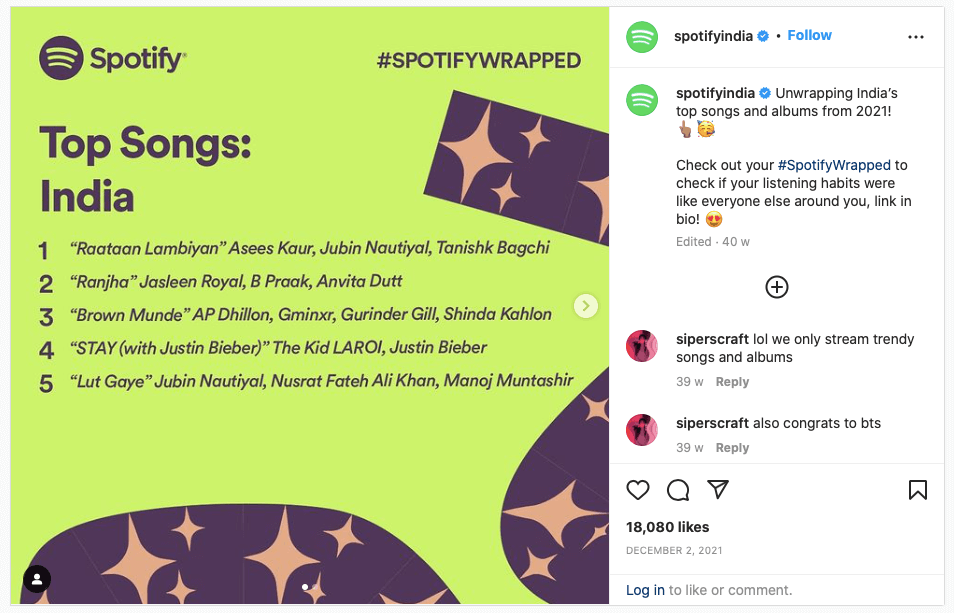
Spotify’s social media team proved their chops with moment marketing too. In response to a user’s impromptu tweet about how the Spotify logo looked similar to Britannia’s Good Day biscuit, Spotify went all in. They changed their logo for a day and entered into a brand banter with Britannia. All of this was executed quickly and, on the go, showing how the social media marketing team was empowered to make quick decisions and execute.
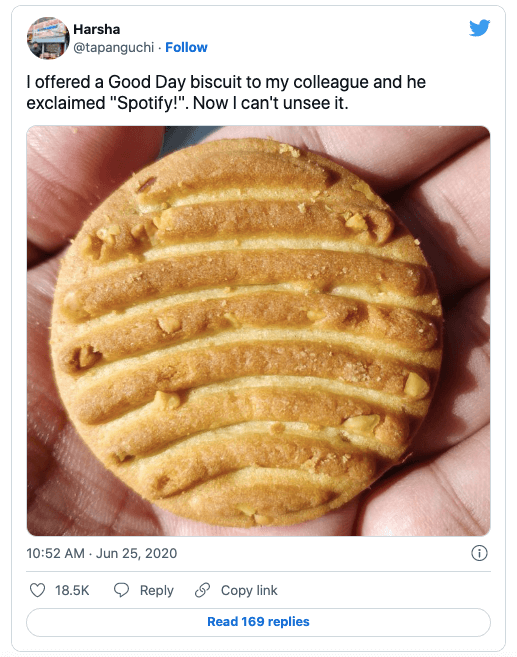
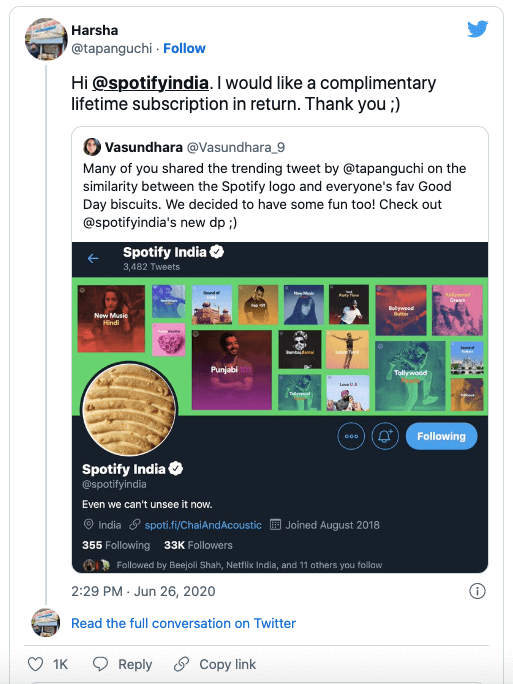
This quick action earned Spotify massive earned media exposure, with major news channels covering it.
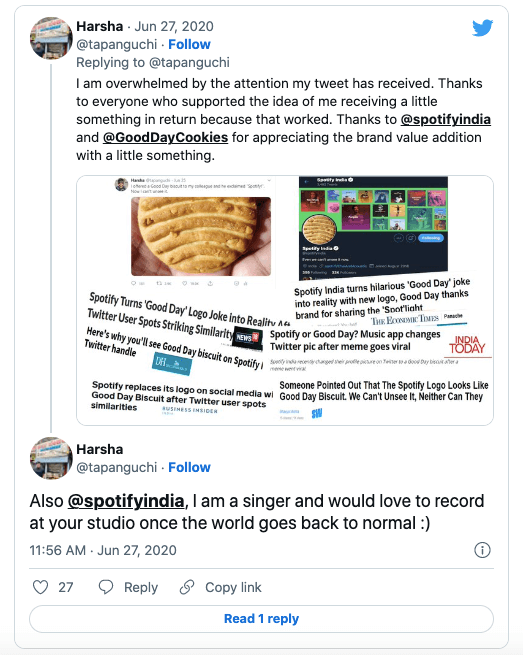
4. Celebrating regional languages and cultural nuances
Spotify then launched regional-specific advertising. Instead of dubbed versions of ads featuring Bollywood heroes, music lovers in Tamil Nadu, Karnataka, Andhra, Kerala and Punjab were served ads made for them.
This was a well thought through move from Spotify’s side since consumption data had shown them that regional music was gaining popularity rapidly. Industry reports noted that Indians actively listen to 22 hours of music weekly, about 3.5 hours more than the global average. And about 83% of that time is spent on consuming local content, with the global average being 49%.
Spotify not only localized their ads, but they also used relevant regional songs to spice them up. They used situations that were amazingly relevant to everyday India, thus making sure the ads had pan India appeal. The ads were built on the insight that even in the midst of the chaos of Indian life, music provides a personal bubble of serenity into which the listener can withdraw.
5. Leveraging podcasts to enhance engagement
India’s podcast market is growing rapidly. Spurred on by the pandemic-induced shutdown, more and more Indians turned to the spoken word as a means of entertainment. India now has the 3rd largest listening base globally (behind US and China). A PwC Global Entertainment & Media Outlook study projects this number to rise to 17.61 million by 2023.
For Spotify, which aims to drive up the time spent by users on the platform, doubling down on the podcast space is a no-brainer.
Spotify now has 150+ Spotify Original and Exclusive podcasts spanning over 13 regional languages, thus showing its intent to turn podcasts mainstream.
Here too, Spotify’s communication has been spot on. For instance, in the latest series of ads to raise awareness for their podcasts, the story is told through a very relatable sibling banter where the younger brother educates his uninformed but curious elder brother about Spotify podcasts.
The casting of Jitendra Kumar is a masterstroke. He has acquired pan India recognition as the famous Jeetu Bhaiyya from Kota Factory and from his role in the hit Amazon Prime series Panchayat. As such, he has earned acceptance and love across town classes and socio-economic tiers in India.
In Summary
Spotify’s story is a great example of a brand using smart, relevant, and insight-led communication to bring alive its positioning, differentiating itself from the competition. Consumers rewarded that consistency and creativity with more engagement, which helped Spotify quickly rise through the ranks to 4th position in India by market share, and #1 in terms of engagement (as per Spotify data).
However, this journey has not always been smooth. For instance, whenever Spotify attempted to bring in celebrities in their communication, it fell some way short of the high benchmarks it had set for itself. The Anil Kapoor – Ishan Khattar series is an example of this. Even the regional ad with Nagarjuna doesn’t really stand out like its other pieces of communication.
However, if you look at Spotify India’s overall communication trajectory, it’s evident that brands can still differentiate themselves vs their competition via strong positioning-led brand building.
In the world of new-age brand building, Spotify definitely deserves a listen.

One Response
Quite detailed and exhaustive analysis